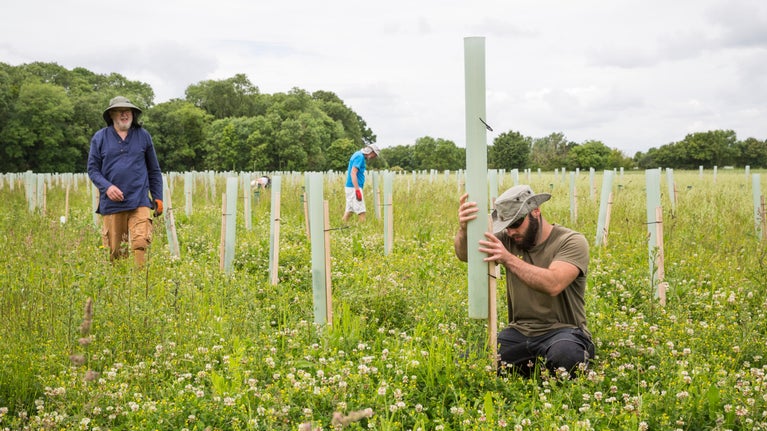
Tackling climate change
Uncover how we’re responding to the changing climate at places in our care.

Connecting the Culm is a partnership project working to tackle challenges faced by the River Culm in Devon, aiming to make the river and its floodplain more resilient to flood and drought and improve water quality and biodiversity. Discover how the river in the Blackdown Hills Area of Outstanding Natural Beauty uses nature-based systems and approaches and wants people living nearby to get involved in the process.
Connecting the Culm is a catchment-based partnership project working to tackle some significant challenges faced by the River Culm in Devon, running from January 2019 until December 2022. It is part of a larger Co-Adapt (climate change adaptation through co-creation) project, part funded by EU Interreg 2 Seas.
The partnership project aims to make the River Culm and its floodplain more resilient to flood and drought, using nature-based systems and approaches; improve water quality and biodiversity on the Culm (and consequently in the Exe and its estuary); and encourage people living in the catchment to feel more involved in decision-making and support the use of nature-based solutions to manage water.
The project will do this firstly by improving local people’s understanding of water management techniques and the function of the river/catchment ecosystem as an integrated whole. It will also create new opportunities for people to collaborate in addressing water management, leading to communities cooperating more effectively to address the challenges created by climate change. As part of this, it will install tangible demonstrations of appropriate nature-based solutions to build confidence, encourage cooperation and raise aspirations – these will be replicable and provide solutions that can be rolled out by the community. Finally, it will develop a Blueprint for the Culm, which will be the masterplan for the whole catchment for the next 25 years, co-created by the people that live and work within the catchment and the organisations that have a role in the area.
This is a case study linked to the Climate and Land Summit hosted by the National Trust at the Wimpole Estate, in Cambridgeshire, on October 12, 2021, before the UN's annual climate conference COP26 in Cornwall in November that year.
Attendees at the summit represented some of England’s largest landowners and managers, and signed up to six guiding principles to commit to collectively working towards the nation’s net zero aims and pressing needs to adapt to a rapidly changing climate. To read the text of the Compact click here.

Uncover how we’re responding to the changing climate at places in our care.

The National Association for Areas of Outstanding Natural Beauty (AONBs) is a registered charity supporting AONBs to ensure their natural beauty is valued.
Learn about the six climate and nature-based targets discussed at the Climate and Land Summit and how the solutions are being applied at National Trust places.

With support from the Government’s Green Recovery Challenge Fund, we're looking for ways to protect our environment and combat climate change. Find out more about the work we're doing.

Discover the vital ways peat supports the environment, from carbon store to archaeological record, and see some of our key projects protecting and restoring the peatland in our care.

We’re tackling the threats of a changing coastline to safeguard the places you love. Find out how our teams are adapting their approach to our shifting shores.

From tips on saving water to combatting plastic pollution, learn more about our work to protect precious coasts and rivers for wildlife and people, and what you can do to help.

Discover more about the National Trust’s role at COP26 in Glasgow and how you can help tackle the climate crisis.
